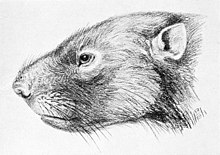Taeniolabis
Taeniolabis ("banded incisor")[2] is a genus of extinct multituberculate mammal from the Paleocene of North America.
Taeniolabis is a member of the Taeniolabidoidea, a superfamily of multituberculates that are known for their highly derived teeth, and a short wide snout with a blocky head.
[3] The teeth modifications were likely an adaptation for herbivory that may have resulted from rapid diversification of angiosperms at the very end of the Cretaceous, which would thus have created opportunities for novel specialization in herbivores.
[4] T. taoensis possessed an elongate, gently curved cochlear canal and an enlarged vestibule.
[9] Taeniolabis taoensis is found frequently enough and in a very limited time range that it can be used as an index fossil for the Puercan faunal stage within Danian aged fossil deposits.


